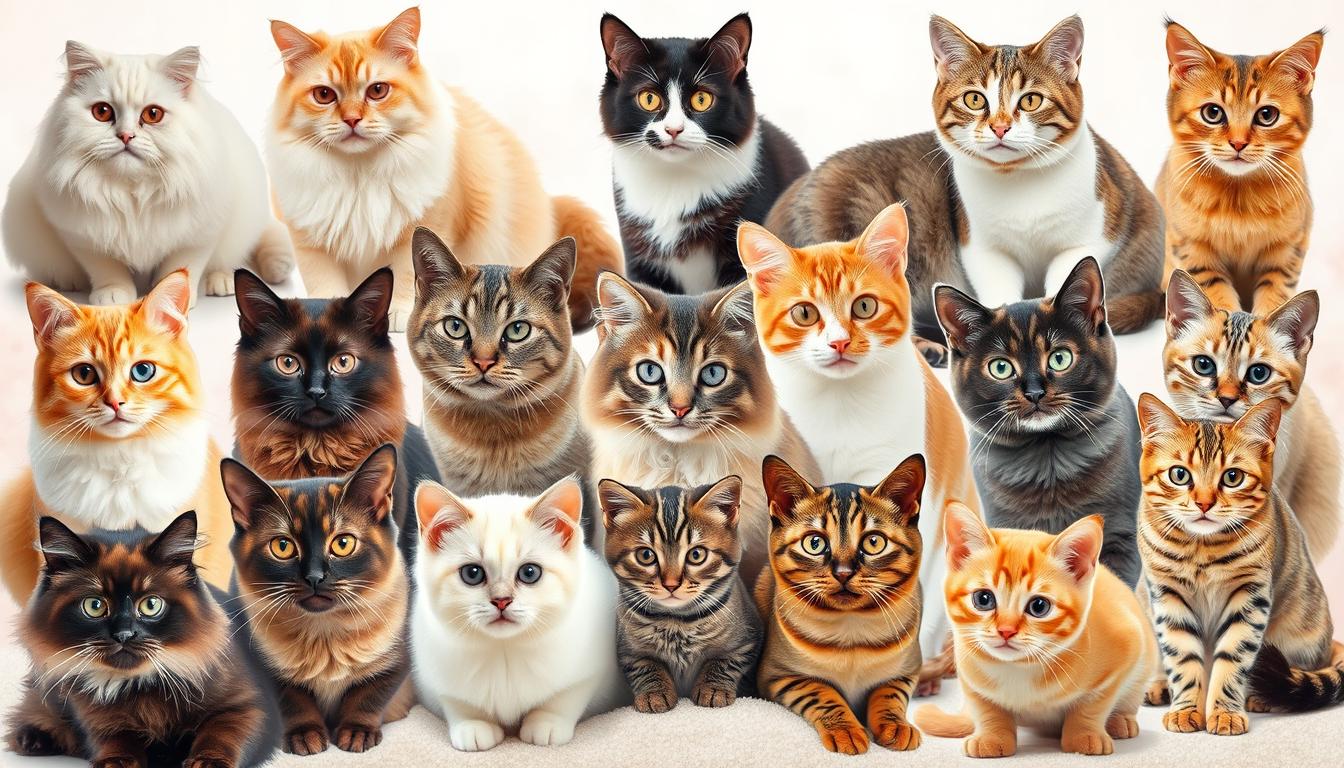Mark Twain once said, “If man could be crossed with the cat, it would improve man, but it would deteriorate the cat.” Cats have won our hearts for thousands of years. They enchant us with their independence, grace, and love. This guide explores the wide world of domestic cat breeds. Each has its own special traits and charm, helping you find your ideal feline friend.
Table of Contents
Understanding Domestic Cat Breeds: A Comprehensive Overview
Domestic cat species have evolved from wild ancestors. Today, we see a wide range of cat types and cat classifications. These changes show how cats have adapted to living with humans over time.
Evolution of Domestic Cats
Cats first appeared about 5.3 to 3.6 million years ago. Despite being domesticated for over 30,000 years, they still keep their wild side. Humans and cats became friends around 15,000-10,000 years ago in the Middle East.
Modern Cat Classifications
Domestic cat types come from all over the world. They’ve adapted to different places and environments. Genetic studies help us understand where some cat breeds come from. Breed standards guide what each cat species should look like.
Importance of Breed Selection
Choosing the right cat type is key. It ensures a cat fits well with its owner’s lifestyle. Some cat breeds face legal issues or need special care. Always check if a breed is right for your home and preferences.
“Cats have been prominent in nursery rhymes, literature, and popular culture, with notable references in works by Aesop, Théophile Gautier, Charles Baudelaire, Rudyard Kipling, Colette, T.S. Eliot, and Andrew Lloyd Webber.”
Maine Coon: The Gentle Giant of North America
The Maine Coon is a majestic cat breed, known for being the largest domesticated cat. Males can weigh up to 22 pounds. They are called “gentle giants” for their size, striking looks, and friendly nature.
These cats have long, shaggy coats and bushy tails, making them look like miniature lions. They are also called “mini lions” because of their fur. Despite their size, they are very gentle and love to please. They bond well with humans and other pets, including children.
Maine Coons have a unique history. They came from a mix of cats brought by Vikings and those from the French Revolution. Today, they are the official state cat of Maine. They have become very popular, being the second most popular cat breed worldwide as of 2023.
| Characteristic | Details |
|---|---|
| Size | Adult male Maine Coons weigh between 18 to 22 lb (8.2 to 10.0 kg), while females weigh from 12 to 15 lb (5.4 to 6.8 kg). The average height ranges from 10 to 16 in (25 to 41 cm), and they can reach a length of up to 38 in (97 cm), including the tail, which can be 14 in (36 cm) long. |
| Coat and Color | Maine Coons have a fur coat that is subject to seasonal variation, thicker in winter and thinner in summer. They come in various colors including brown tabby, solid, tortoiseshell, and calico, and typically have green, gold, or copper-colored eyes. |
| Temperament | Known as the “dogs of the cat world,” Maine Coons are friendly, intelligent, trainable, and loyal, making them great pets for families with children. They are also known for their unique vocalizations, including chirping and trilling in addition to meowing. |
If you’re looking for a large, friendly cat, the Maine Coon is perfect. Their size, looks, and loving nature make them a true treasure of North American feline heritage.
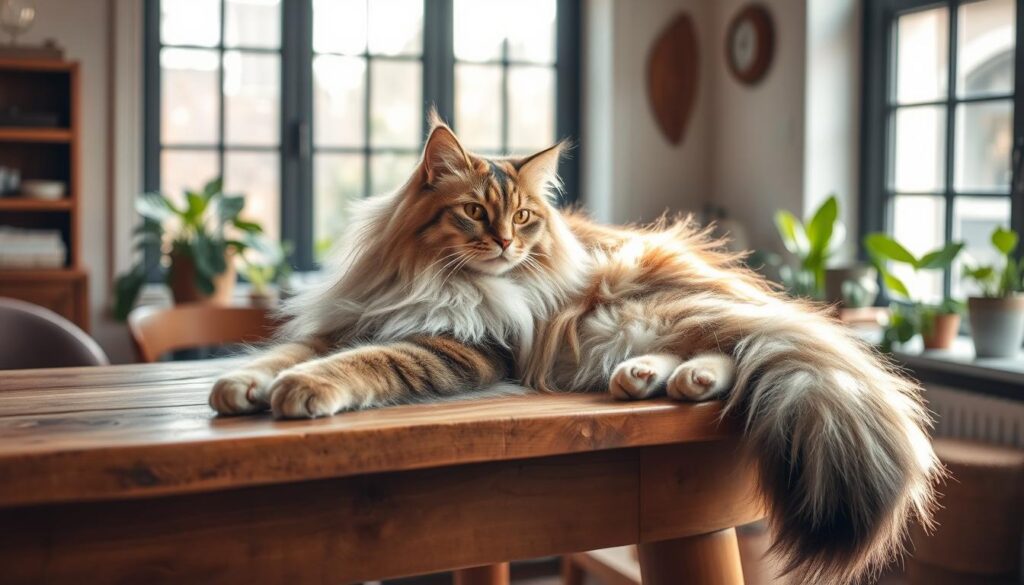
Siamese: Vocal and Sophisticated Companion
Siamese cats are known for their loud voices and sleek looks. They have bright blue eyes and short, shiny fur. These cats have won the hearts of many since they arrived in Europe and North America in the 19th century.
Distinctive Physical Features
Siamese cats are medium-sized, weighing 8 to 10 pounds. They’ve been recognized by the Cat Fanciers’ Association since 1906. They come in four colors: seal, chocolate, blue, and lilac. Their eyes and fur make them look stunning.
Personality Traits and Care Requirements
Siamese cats are smart, curious, and love to move. They need lots of attention and can get sad if left alone. They bond strongly with their families and are great for busy homes. But, they need regular grooming and may face dental and respiratory problems.
Social Behavior Patterns
Siamese cats are very social. They are loyal and loving, forming close bonds with their owners. They talk a lot, using different sounds to get what they want. It takes a year for Siamese kittens to show their full colors, but their unique looks and personalities make them special.
| Siamese Cat Breed Facts | Details |
|---|---|
| Average Weight | 8-10 pounds |
| Recognition by CFA | 1906 |
| Lifespan | 12-16 years |
| Point Colors | Seal, Chocolate, Blue, Lilac |
| Personality Traits | Intelligent, Curious, Active |
| Common Health Issues | Dental, Respiratory, Amyloidosis |
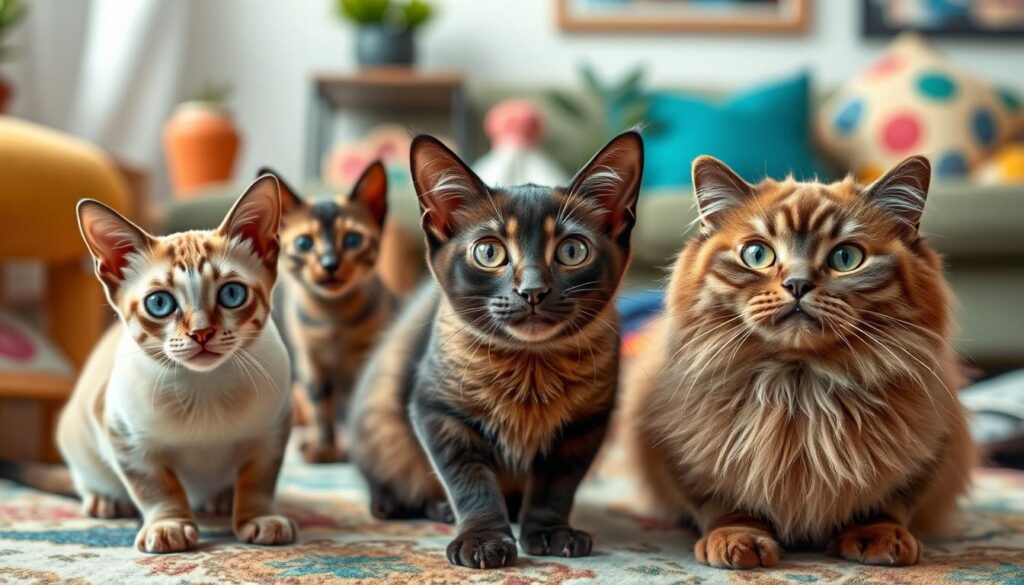
“Siamese cats are the extroverts of the feline world, always ready to engage with their beloved owners and demand attention.”
Persian: The Luxurious Lap Cat
If you’re looking for a gentle, loving cat, the Persian might be ideal. They are known for their long, flowing coats and flat faces. These long-haired cat breeds are truly elegant and graceful.
Persian cats weigh between 7 to 12 pounds and are 10 to 15 inches tall. They love to relax on laps or soft cushions. This makes them perfect calm cat breeds for those who enjoy quiet time.
Persian cats come from Iran and are loved for their beauty and calm nature. Their beautiful coats need daily grooming to keep them looking great. This means they are best for owners who enjoy grooming their pets.
Even though their coats are high maintenance, Persian cats are generally laid-back. They are happy to spend their days in a cozy home.
“Persian cats embody the essence of sophistication and tranquility, making them the perfect lap cats for those seeking a loyal and affectionate companion.”
Persian cats can live up to 17 years, bringing joy and companionship for a long time. Buying a Persian cat from a good breeder can cost between $1,300 to $5,000. This shows how much people value their unique qualities.
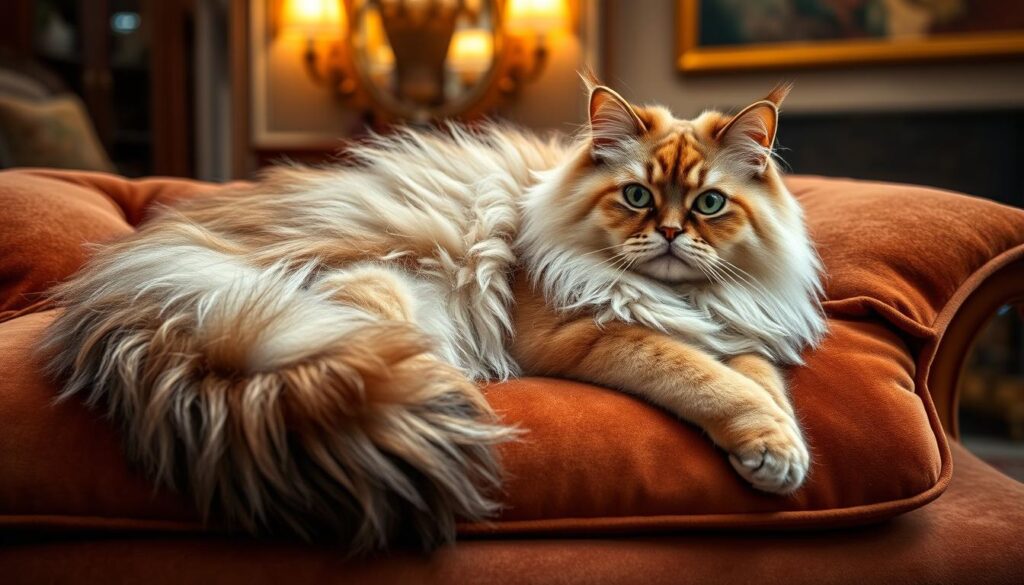
Types of Domestic Cats: From Purebred to Mixed Breeds
Cats come in two main types: purebred and mixed breeds. Knowing the difference between these domestic feline breeds helps you choose the right cat for your family.
Common Breed Categories
Purebred cats have a known family history and meet breed standards. They have set physical traits, personalities, and health. Mixed breed cats, on the other hand, have a mix of genes, leading to unique looks and behaviors.
Understanding Mixed Breeds
Mixed breed cats are becoming more popular. They often have better health and are less expensive than purebred cats. This is because they have a wider range of genes.
Health Considerations by Type
Purebred cats are known for their looks but may have health issues. Mixed breed cats, with their varied genes, tend to be healthier. It’s important for pet owners to know about health risks for both types to care for their cats well.
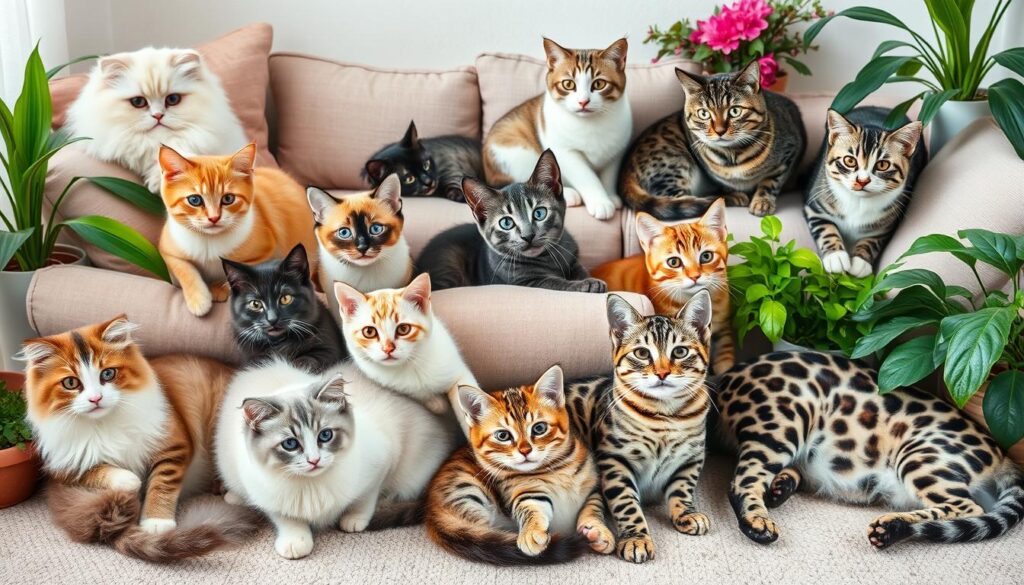
Whether you prefer the predictability of purebred cats or the uniqueness of mixed breed cats, there’s a cat for everyone. Understanding the differences helps you choose the right cat for your home.
Bengal: Wild Beauty in Your Home
Are you dreaming of owning an exotic cat? The Bengal might be just what you’re looking for. These cats look like mini leopards with their striking coats. They have a wild beauty and a domestic charm that’s hard to resist.
But, owning a Bengal comes with a big responsibility. They need lots of stimulation and an active lifestyle. This is because they have a lot of energy.
Bengals are super smart and full of energy. They love to play, solve puzzles, and even go for walks on a leash. What’s even more unique is their love for water. They can even be trained to use the toilet!
While Bengals can be very loving, they’re not for everyone. They can grow up to 18 pounds and need lots of exercise. They have a muscular build that needs regular activity to stay happy and healthy.
“Bengal cats are the ultimate combination of wild beauty and domestic charm. Their intelligence and energy make them a rewarding, but challenging, pet choice.”
If you’re up for the challenge, a Bengal could be a great fit. They bring a wild elegance into your home. If you’re ready for an active and loving pet, a Bengal might be the perfect choice for you.
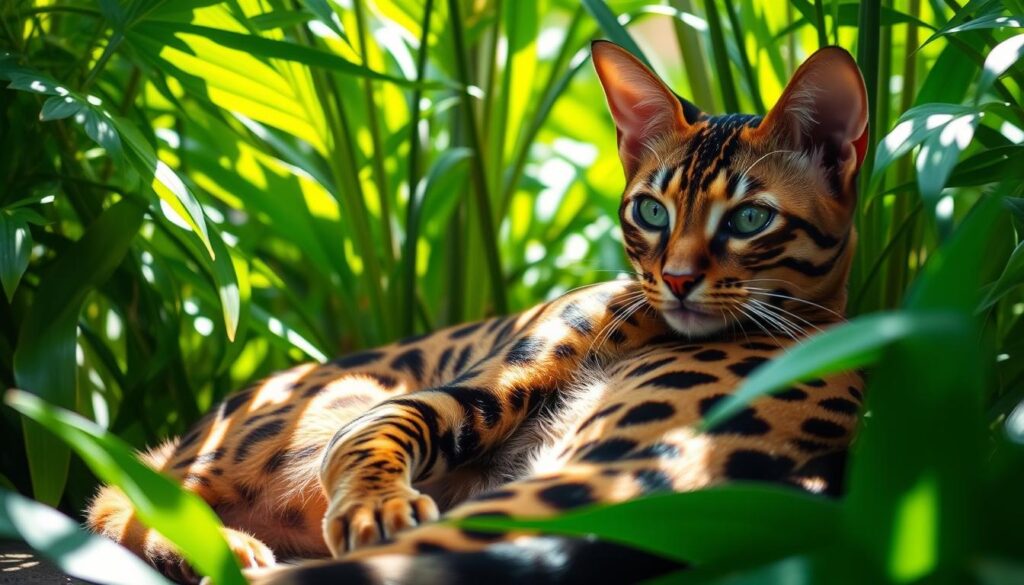
Ragdoll: The Affectionate Family Companion
If you’re looking for a big, loving cat, the Ragdoll is perfect. These cats are huge, with beautiful blue eyes and soft fur. They love to cuddle, which is why they’re called Ragdolls.
Ragdolls are very calm and loving, like puppies. They enjoy spending time with their family.
Physical Characteristics
Ragdolls are among the biggest cat breeds, weighing 10 to 20 pounds. They have striking colors, with a light body and darker points. Their fur is long and silky, needing regular grooming.
Temperament and Training
Ragdolls are great with kids and other pets. They love to be around people and will follow you everywhere. They’re easy to teach tricks, making them fun to have around.
They’re very patient and love to please. This makes them ideal for families looking for a family-friendly cat breed.
| Trait | Description |
|---|---|
| Size | Large, weighing 10 to 20 pounds |
| Coat | Semi-long, soft and silky |
| Color | Bi-color or point coloration |
| Temperament | Calm, placid, and affectionate |
| Sociability | Highly social, tolerant of children and other pets |
| Training | Easy to train, eager to please |
Ragdoll cats are perfect for families. They’re big, gentle, and very loving. Their calm and friendly nature makes them great for any home.
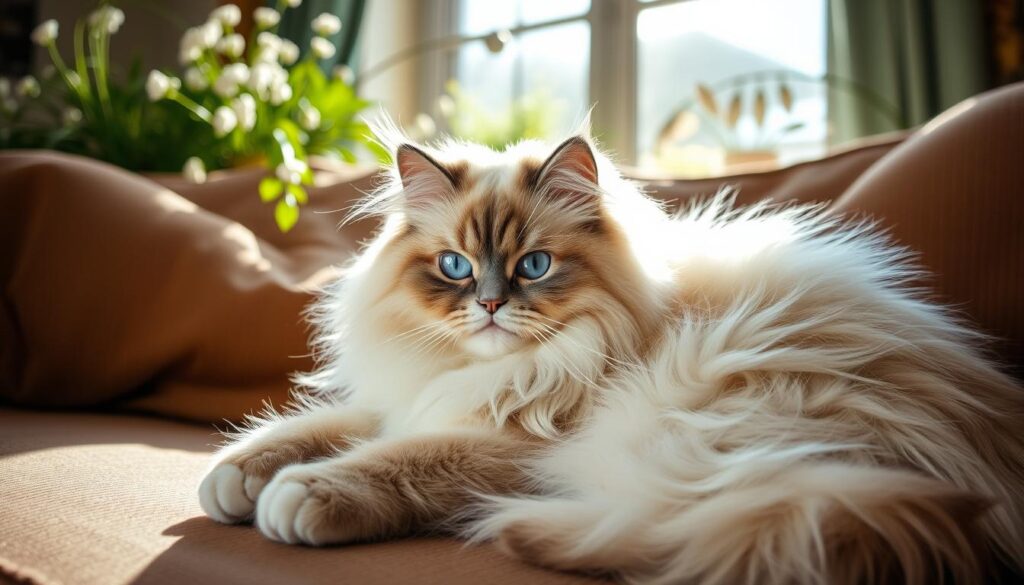
Abyssinian: The Active Explorer
Meet the Abyssinian, one of the oldest and most lively cat breeds. They come from ancient Egypt and have a unique ticked coat. This gives them a wild look. They are medium-sized, weighing 7-10 pounds, and known for their energy, curiosity, and smarts.
Abyssinians aren’t just lap cats. They love to explore and play. These energetic cat breeds enjoy climbing, jumping, and checking out their surroundings. They need lots of space and fun toys to keep them happy.
Even though they’re always on the move, Abyssinians bond strongly with their owners. They might follow you everywhere, wanting to join in. These ancient cat breeds are smart and can learn games and tricks. They’re great for families who can keep up with their energy and love for fun.
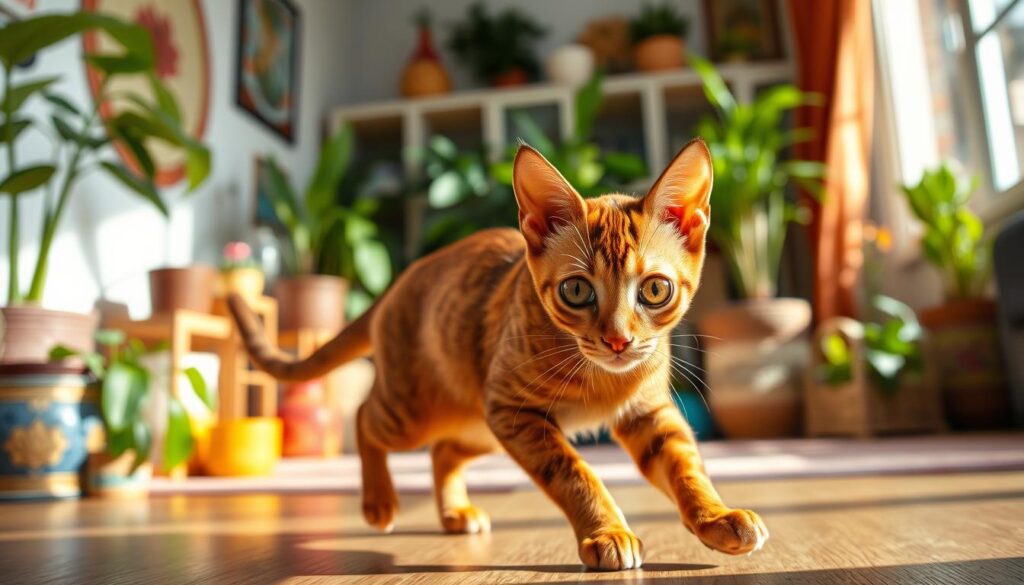
“Abyssinians are the perfect feline for those who want an energetic, curious, and intelligent companion to share their adventures.”
British Shorthair: Classic Charm and Elegance
The British Shorthair is a timeless beauty, loved by many around the world. They have round faces, big eyes, and soft, thick fur. Their history goes back to Roman times, making them a staple in the UK.
Historical Background
In the early 1900s, Harrison Weir helped make the British Shorthair a recognized breed. The first cat show for them was in 1871 at the Crystal Palace in London. This event helped them become beloved pets, not just working animals.
Today, they are celebrated by cat registries like the Cat Fanciers’ Association (CFA) and The International Cat Association (TICA). This makes them a favorite among cat lovers.
Care and Maintenance
- Their thick fur needs regular grooming to avoid tangles and reduce shedding.
- They can get sick with Hypertrophic Cardiomyopathy (HCM) and Polycystic Kidney Disease (PKD). Regular vet visits are key.
- They might get fat because they’re calm and not very active. So, a balanced diet and exercise are important.
- British Shorthairs can live up to 15 years or more. So, getting one is a big commitment.
The British Shorthair’s charm and elegance make them a popular choice. They are calm, loving, and easy to care for. They’re perfect for those who want a low-maintenance, yet beautiful, pet.
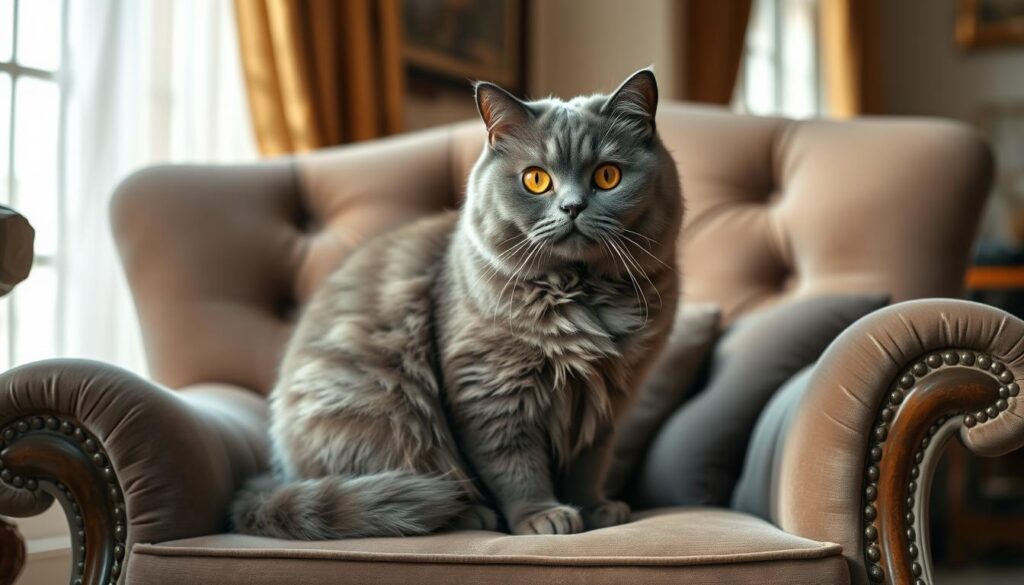
Sphynx: The Unique Hairless Beauty
If you’re looking for a unique feline friend, the Sphynx cat might be perfect. They have no fur but a medium-sized body, large ears, and suede-like skin. These cats are loving, playful, and enjoy snuggling with their owners.
Sphynx cats are outgoing and social, often following their owners. They need regular baths to remove oils from their skin. This makes them a good choice for those with cat allergies. Yet, some people might still react to their skin oils.
The Sphynx’s look comes from a natural genetic mutation. This mutation affects the KRT71 gene, causing hairless skin. Other breeds, like the Devon Rex and Selkirk Rex, also have this gene but look different.
Sphynx cats are sensitive to cold and heat. They do best indoors, needing clothes or heated beds in cold weather. In hot weather, they need protection from sunburn and heat. They also need a diet rich in calories and protein to stay warm.
Despite needing special care, Sphynx cats are loved for their playful and affectionate nature. They are a unique choice for those interested in hairless cat breeds or hypoallergenic cat breeds.
| Breed | Origin | Cost | Lifespan |
|---|---|---|---|
| Bambino | Founded in 2005 | $2,000 to $2,800 | 8-14 years |
| Lykoi | Established | Around $1,000 | 8-14 years |
| Ukrainian Levkoy | Established in 2004 | Up to $2,000 | 8-14 years |
| Sphynx | Originated in Canada in 1966 | Varies | 8-14 years |
The Sphynx cat breed was recognized by the Cat Fanciers’ Association in 2002. They are popular worldwide for their unique looks, loving nature, and special care needs. Sphynx cats truly stand out among feline friends.
Scottish Fold: Distinguished by Folded Ears
The Scottish Fold is a unique cat breed known for its folded ears, giving it an owl-like look. These cats have round faces, large eyes, and soft coats. They are sweet and gentle, making them great companions for many homes.
Special Care Requirements
The folded ear gene is a key feature of the Scottish Fold. But, it can also cause health problems. Scottish Fold owners must watch their pets’ ear health closely and take care of them to avoid issues.
Health Considerations
- Scottish Folds may have osteochondrodysplasia, a genetic issue with cartilage and bones.
- They can also get polycystic kidney disease (PKD) and cardiomyopathy, so regular vet visits are key.
- Keeping them healthy with the right diet and care can prevent many health problems.
Scottish Folds need regular play to stay fit. They should play for 10-15 minutes, a couple of times a day. Long-haired ones need daily brushing, while short-haired ones should be brushed weekly to avoid matting.
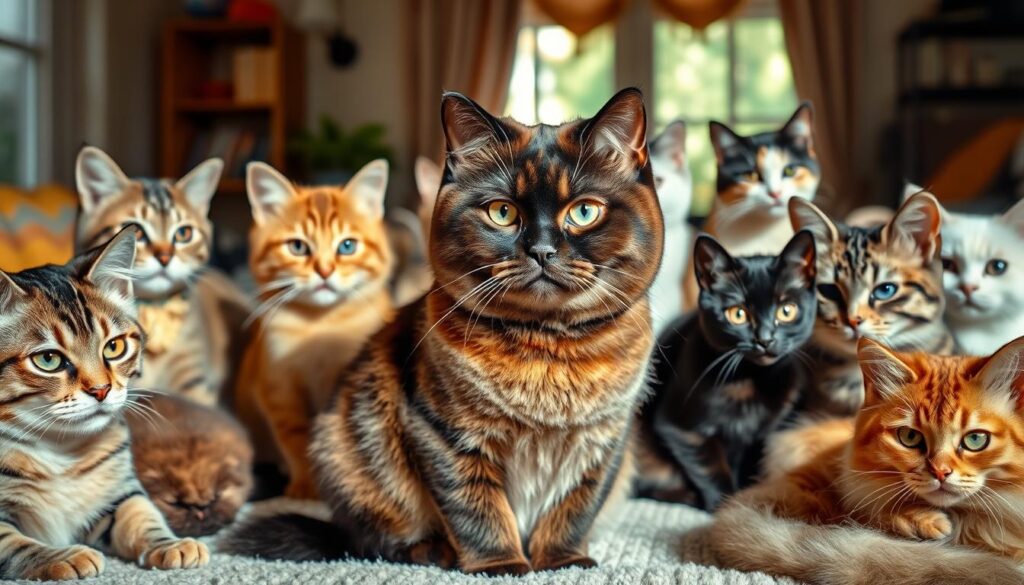
“Responsible breeders of Scottish Fold cats prioritize the health and well-being of the cats and ensure that breeding pairs do not pass on deleterious traits.”
| Breed Characteristic | Details |
|---|---|
| Appearance | The Scottish Fold is a medium-sized cat with a round face, large eyes, and folded ears, giving it a distinctive owl-like look. Its coat can be short or long, with a variety of colors and patterns. |
| Temperament | Scottish Folds are known for their sweet and gentle nature, making them excellent companions. They adapt well to various living situations and enjoy interactive play. |
| Health Concerns | The folded ear gene can lead to osteochondrodysplasia, a condition affecting cartilage and bone development. Scottish Folds may also be predisposed to polycystic kidney disease (PKD) and cardiomyopathy. |
| Care Requirements | Scottish Fold cats require regular veterinary check-ups, a healthy diet, and proper grooming. Long-haired Scottish Folds need daily brushing, while short-haired Scottish Folds require weekly brushing. |
Devon Rex: The Pixie of the Cat World
Get ready to fall in love with the Devon Rex. This cat has a short, curly coat that makes it look like a pixie. They are playful and loving, with a lively and sometimes mischievous spirit.
The Devon Rex has big ears, a slender body, and a face that will catch your eye. Their coat is easy to care for, making them a great choice for anyone looking for a fun and low-maintenance pet.
Despite their soft-looking coat, Devon Rex cats are strong and agile. They love to climb and jump, which makes them entertaining to watch. Whether they’re cuddling on the couch or running around, they always keep things interesting.
It’s important to know about the health issues that Devon Rex cats might face. They can get sick with conditions like heart problems and joint issues. Regular vet visits and good care are key to keeping them healthy.
If you want a playful and short-haired cat breed that’s full of life, the Devon Rex is perfect. Their friendly nature and easy-to-maintain coat make them a great addition to any home.
| Trait | Description |
|---|---|
| Appearance | Small to medium-sized, with a short, curly coat that gives them a “pixie-like” look. Large ears, slender bodies, and mischievous expressions. |
| Personality | Playful, affectionate, and energetic. Known for their acrobatic abilities and love of exploration. |
| Grooming | Low-maintenance coat, but can be prone to skin conditions like feline atopic dermatitis and Malassezia dermatitis. |
| Health Concerns | Prone to genetic conditions like feline aortic thromboembolism, Vitamin K-dependent coagulopathy, and patellar luxation. Regular veterinary care is essential. |
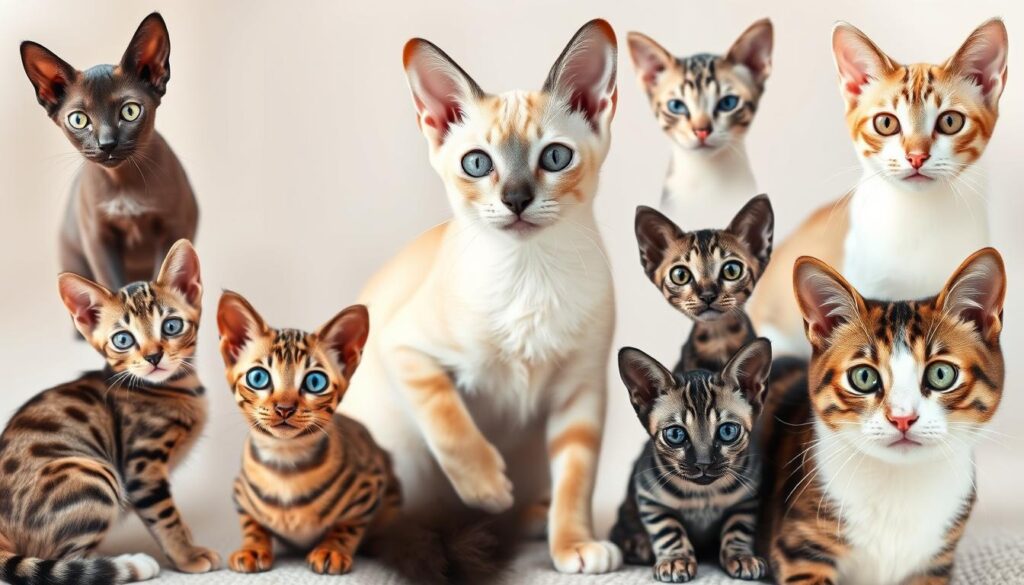
The Devon Rex breed started in England in the late 1950s. It has won the hearts of cat lovers everywhere with its unique look and fun personality. If you’re looking for a short-haired cat breed or a playful friend, the Devon Rex could be the perfect match for you.
Russian Blue: Mysterious and Gentle
Russian Blue cats have a stunning silvery-blue coat and bright green eyes. They are medium-sized, muscular, and graceful. Originating from Russia, they were first recorded outside their homeland in the 1800s. They made their way to Great Britain and Northern Europe around 1860.
These cats quickly became popular, showing up in cat shows in England as early as 1872. They were known as “Archangel Cats.” Breeders in Europe, like those in England and Scandinavia, helped shape the breed.
They were favored by European royalty. After World War II, American breeders improved the Russian Blue by mixing Scandinavian and British lines.
The Russian Blue’s coat is silvery-grey and often seems to have a bluish sheen. Their faces are wedge-shaped, unlike the rounder faces of typical grey cats. They stand about 10 inches tall and weigh around 12 pounds, with a slim, muscular build.
Russian Blues are known for their gentle and affectionate nature. They are quiet cats, with little meowing, even at night. They are also among the most fearful cat breeds, being reserved, mainly around strangers. Yet, they bond deeply with their owners and enjoy playing, even when alone.
They are also known for their grooming habits, spending a lot of time on their low-shedding coats. This makes them hypoallergenic, a great choice for those looking for a quiet, gentle, and easy-to-care-for pet.
“The Russian Blue is a cat of mystery and grace, with a captivating gaze that leaves a lasting impression.”
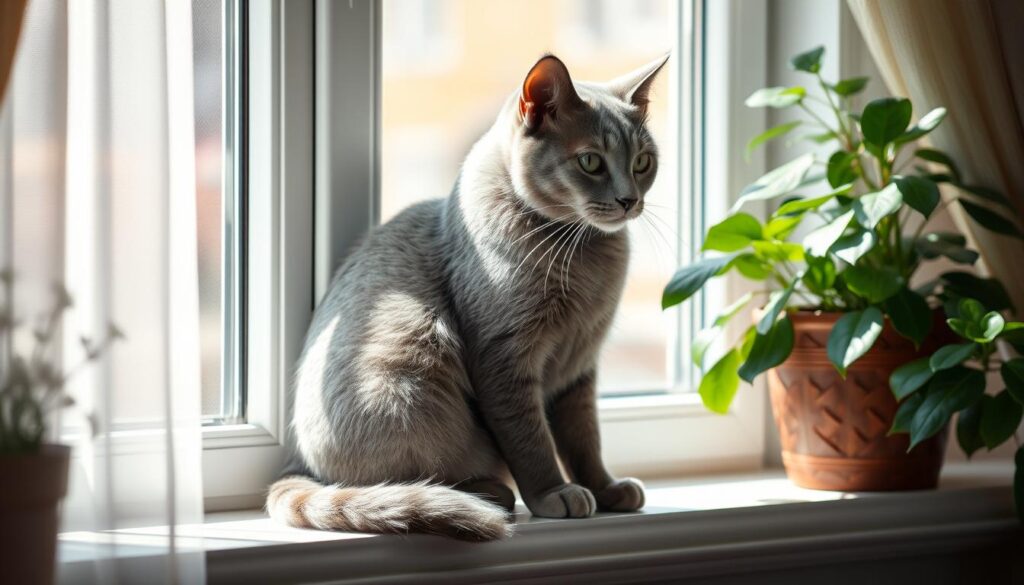
Exotic Shorthair: The Low-Maintenance Persian
Are you drawn to the Persian cat’s charm but worried about their grooming needs? The Exotic Shorthair is a great choice. They have the Persian look but with a coat that’s easy to care for.
Exotic Shorthairs are like short-haired Persians. They have the same cute face and sturdy body. They are calm and loving, perfect for seniors or those living in apartments.
Grooming Needs
Exotic Shorthairs need much less grooming than Persians. While Persians need daily brushing, Exotic Shorthairs just need a weekly brush. This makes them great for people who don’t want to spend a lot of time grooming.
Living Requirements
Exotic Shorthairs can live in big houses or small apartments. They are calm and don’t need a lot of space. But, they should see the vet regularly to check for health issues.
If you love the Persian look but want something easier to care for, the Exotic Shorthair is a good choice. They are loving, easy to groom, and fit well in different homes. They make wonderful pets for those who want a low-maintenance companion.
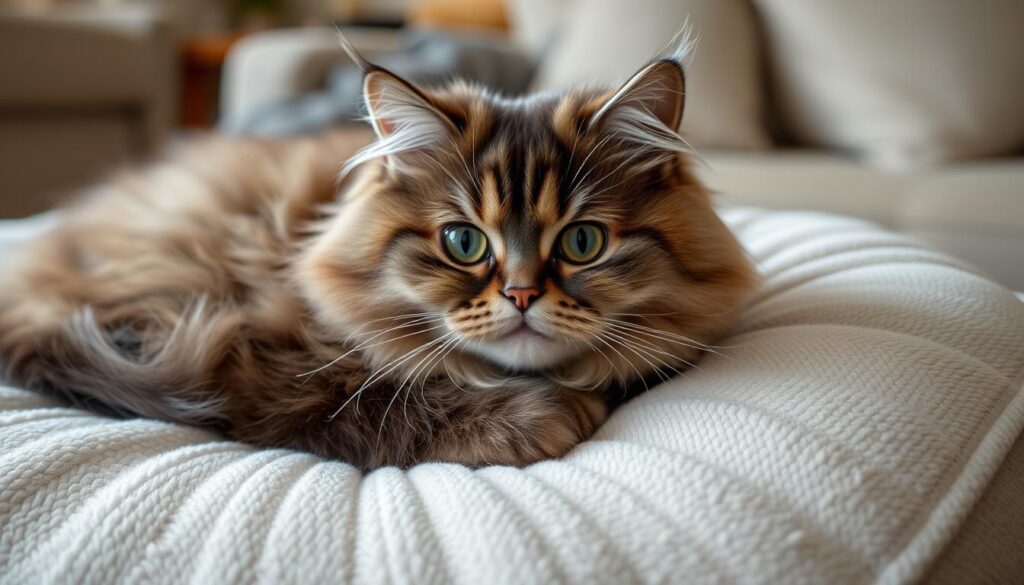
Conclusion: Finding Your Perfect Feline Match
Choosing the right cat breed is all about your lifestyle, living space, and what you like. Each breed has its own special traits, like the Maine Coon’s size or the Sphynx’s lack of fur. Think about their energy, grooming needs, and personality to find the best match.
Purebred cats are rare, making up less than 1% of all cats. Yet, there are about 70 recognized breeds to choose from. You might like the Persian or Siamese, or maybe the Bengal or Scottish Fold. Going to a cat show can help you see what you like and meet different cats.
Mixed breeds are also worth considering. They can mix different traits and might be healthier. Adopting a cat can add joy and a special friend to your home. Do your research and meet different cats before deciding. The right cat will make your life better for many years.
FAQ
What are the different types of domestic cats?
Domestic cats come in many breeds. You can find everything from the big Maine Coon to the hairless Sphynx. Popular breeds include Siamese, Persian, and Bengal. Also, Ragdoll, Abyssinian, British Shorthair, and Russian Blue are favorites.
How do I choose the right cat breed for my lifestyle?
Think about your lifestyle when picking a cat breed. Look at their activity level, grooming needs, and temperament. For example, Ragdoll and British Shorthair are calm and easy to care for. But Bengals and Abyssinians are more energetic and need more playtime.
What are the differences between purebred and mixed breed cats?
Purebred cats have certain looks and a known family history. Mixed breeds have more genetic variety. Purebreds might face health issues, but mixed breeds often have fewer problems. Both can be great pets, depending on what you prefer.
Are there any legal or housing considerations for exotic cat breeds?
Yes, exotic breeds like Bengals might have special rules in some places. Always check the laws in your area before getting an exotic breed.
How much grooming do different cat breeds require?
Grooming needs vary by breed. Short-haired cats like Siamese need little grooming. But long-haired cats, like Persians, need regular brushing to avoid tangles.
Do certain cat breeds have special care requirements?
Yes, some breeds need special care. For example, Scottish Folds need ear care to avoid health problems. Sphynx cats need baths to keep their skin clean.
Are there any hypoallergenic cat breeds?
The Sphynx cat is often seen as hypoallergenic because it has no fur. But some people still react to their skin oils. Breeds like Siberian and Russian Blue might be better for those with allergies because they shed less.
